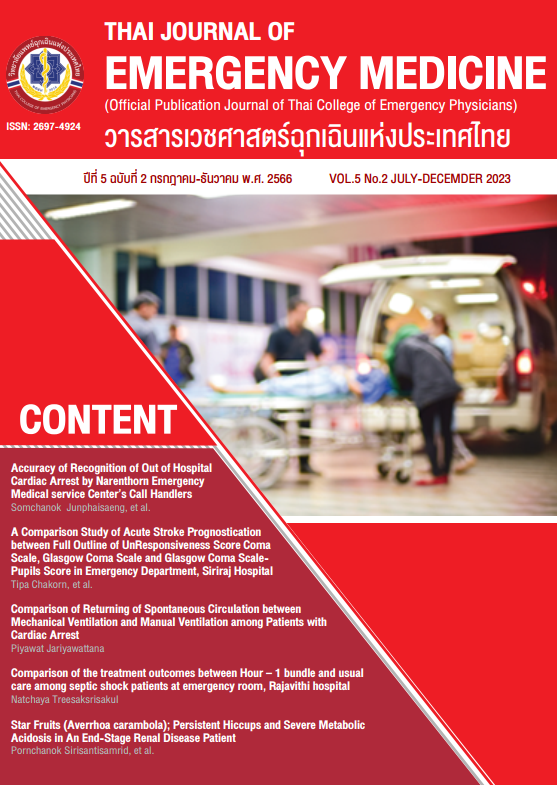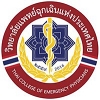Accuracy of Recognition of Out of Hospital Cardiac Arrest by Narenthorn Emergency Medical service Center’s Call Handlers
Keywords:
ภาวะหัวใจหยุดเต้นนอกโรงพยาบาล, คำรับแจ้งเหตุ, ความแม่นยำในการวินิจฉัย, ผู้จ่ายงานปฏิบัติการฉุกเฉินศูนย์กู้ชีพนเรนทรAbstract
Introduction Sudden cardiac arrest is an emergency medical condition requiring immediate resuscitation. Early recognition of cardiac arrest and proper resuscitation are important factors to increase survival rate of OHCA
Objectives To evaluate accuracy of recognition of OHCA in unconscious patients and factors that associate with recognition of OHCA patients by Narenthorn Emergency Medical dispatcher center
Method This retrospective, diagnostic study includes 453 unconscious patients who were reported to Narenthorn Emergency Medical service Center and treated by emergency medical personnel in Bangkok from 1/1/2018 – 31/12/2021. Data was analysed to identify accuracy of recognition of OHCA by kappa coefficient and factors associated diagnosis of OHCA patients by multiple logistic regression analysis.
Results Accuracy between pre-arrival recognition of OHCA and actual OHCA is substantial with kappa coefficient 0.74 (95%CI: 0.674 - 0.806). Patients who were unconscious and apnea have greater risk of actual OHCA with adjusted odd ratio of 0.21 (95%CI: 0.09 - 0.50, p-value < 0.001) compared to patients who were only unconscious with no other symptoms.
Conclusion Accuracy of recognition of unconsciousness and OHCA is substantial. Reports of ‘unsciousness and apnea’ and, ‘unconsciousness’ were highly diagnosed OHCA.
References
Perkin GD, Handley AJ, Koster RW, Castren M, Smyth MA, Olasveengen T, et al, European Resuscitation Council guidelines for resuscitation 2015: section2. Adult basic life support and automated external defibrillation. Resuscitation. 2015 Oct;95:81-99.
Lee SY, Ro YS, Shin SD, Song KJ, Hong KJ, Park JH, et al. Recognition of out of hospital cardiac arrest during emergency call and public awareness of cardiopulmonary resuscitation in communites: A multilevel analysis. Resuscitation. 2018;128:106-11.
Cairns KJ, Hamilton AJ, Marshall AH, Moore MJ, Adgey AA, Kee F. The obstacles to maximizing the impact of public access defibrillation: An Assessment of the dispatch mechanism for out of hospital cardiac arrest. Heart. 2008;94(3):349-53.
Lim Swee H., Chee Tek S, Wee Fong C., Tan Siew H, et al. Singapore Basic Cardiac Life Support And Automated External Defibrillation Guideline 2021. Singapore Med J 2021; 62(8): 415-423.
Viereck S, Moller TP, Rothman JP, Folke F, Lippert FK. Recognition of out of hospital cardiac arrest during emergency calls-a systemic review of observation studies. Scand J Trauma Resusc Emerg Med. 2017;25(1):9
Breindahl N, Granholm A, Jensen Theo W, Ersboll Annette K, et al. Assessment of breathing in cardiac arrest: a randomised controlled trial of three teaching methods among laypersons. BMC Emergency Medicine (2021) 21:114.
Watkins CL, Jones SP, Hurley MA, Benedetto V, Proce Cl, Sutton CJ, et al. Predictor of recognition of out of hospital cardiac arrest by emergency medical services call handlers in England A mixed methods diagnostic accuracy study. Scand J Trauma Resusc Emerg Med. 2021;29(1):7.
American Heart Association. Highlights of the 2020 American Heart Association guidelines for CRR and ECC 2020;6.
Claire H, Scott B, Chen Ji, Samantha B, Andrew Wh, James M. Epidemiology and outcome from out-of-hospital cardiac arrests in England. Resuscitation 2017;110:133-40.
Downloads
Published
How to Cite
Issue
Section
Categories
License
Copyright (c) 2024 Thai Collage of Emergency Physicians

This work is licensed under a Creative Commons Attribution-NonCommercial-NoDerivatives 4.0 International License.
บทความที่ได้รับตีพิมพ์ในวารสารเวชศาสตร์ฉุกเฉินแห่งประเทศไทย ถือเป็นเป็นลิขสิทธิ์ของ วิทยาลัยแพทย์เวชศาสตร์ฉุกเฉินแห่งประเทศไทย
กรณีที่บทความได้รับการตีพิมพ์ในวารสารเวชศาสตร์ฉุกเฉินแห่งประเทศไทยแล้ว จะตีพิมพ์ในรูปแบบอิเล็กทรอนิกส์ ไม่มีสำเนาการพิมพ์ภายหลังหนังสือเผยแพร่เรียบร้อยแล้ว ผู้นิพนธ์ไม่สามารถนำบทความดังกล่าวไปนำเสนอหรือตีพิมพ์ในรูปแบบใดๆ ที่อื่นได้ หากมิได้รับคำอนุญาตจากวารสารเวชศาสตร์ฉุกเฉินแห่งประเทศไทย




